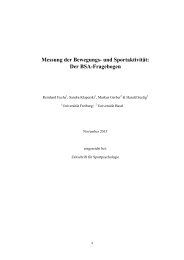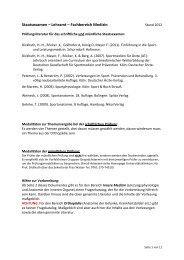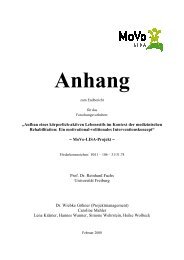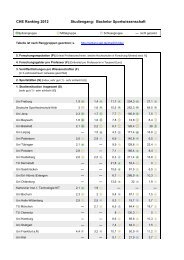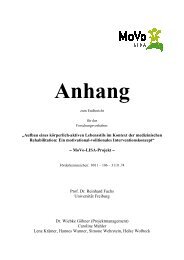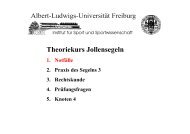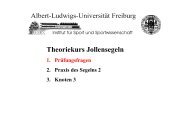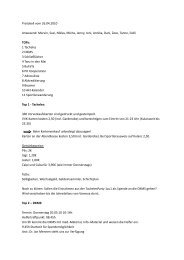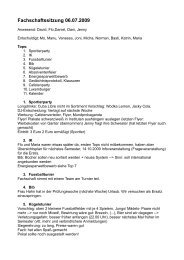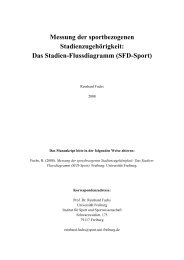Barrieren und Barrierenmanagement im Prozess der Sportteil ...
Barrieren und Barrierenmanagement im Prozess der Sportteil ...
Barrieren und Barrierenmanagement im Prozess der Sportteil ...
Erfolgreiche ePaper selbst erstellen
Machen Sie aus Ihren PDF Publikationen ein blätterbares Flipbook mit unserer einzigartigen Google optimierten e-Paper Software.
Abstract - englisch<br />
Barriers and barrier management in physical exercise: Introduction of two new assessment<br />
instruments<br />
Backgro<strong>und</strong>. In the literature on health behaviour change, the term ‘barrier’ is often used to<br />
describe different constructs. We propose that two types of barriers need to be distinguished:<br />
negative outcome expectancies (expectations about the consequences of the behaviour) and<br />
situational barriers (high risk situations which <strong>im</strong>pede the realisation of the behaviour). In<br />
or<strong>der</strong> to surmount these barriers, an effective barrier management is needed. The objective of<br />
the present study was to develop and evaluate two scales to measure situational barriers for<br />
physical exercise and to measure the corresponding barrier management. Method. Self-<br />
report data were taken from 692 orthopedic patients six weeks after their stay in a rehabilita-<br />
tion clinic. Additionally to the scales on situational barriers (13 items) and barrier manage-<br />
ment (15 items), the questionnaire included measures of negative outcome expectations, self-<br />
efficacy, goal intention and physical exercise. Results. A factor analysis of the situational<br />
barriers provided two subscales (“physical barriers”, Cronbach’s α= .74; and “psychosocial<br />
barriers”, α= .83). With regard to barrier management again two factors emerged: preventive<br />
barrier management (α= .71) and acute barrier management (α= .68). Correlation and regres-<br />
sion analyses provided evidence for the validity of the scales. Discussion. The two new<br />
scales may contribute to a better <strong>und</strong>erstanding of the motivational and volitional processes<br />
<strong>und</strong>erlying physical exercise participation. Furthermore, both scales may be valuable instru-<br />
ments for practical interventions in sport and health psychology.<br />
Keywords: situational barriers, barrier management, volition, assessment instruments, physi-<br />
cal exercise<br />
3



